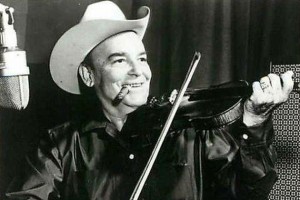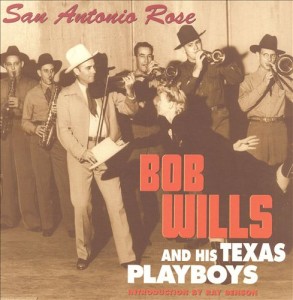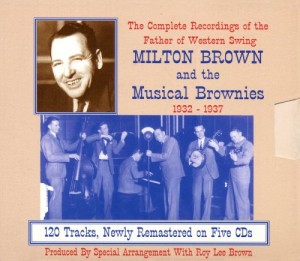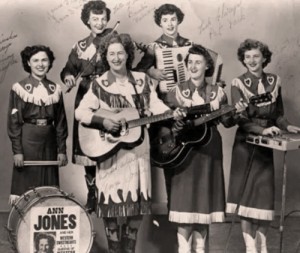Written by Courtney Gonzalez and Daniela Torres. 25 February 2015
Western Swing originated during the late nineteen twenties in Fort Worth Texas. Being the end point of the railroad and traveling livestock, Fort Worth turned into a financial hub. The influx of travelers and money changed the Fort Worth entertainment industry to support the new innovating sound of Western Swing. Western Swing was a fuse of different musical cultures and instruments that aimed to get the crowd out on the dance floor. The two most well known Western Swing artists were Milton Brown and Bob Wills who are credited with creating and popularizing Western Swing respectively. Cecil Brower is among the influential Western Swing artists, just not at Brown and Wills status. Starting off in the same band, Wills and Brown began their careers in the Light Crust Doughboys. Brown was interested in focusing the bands attention on the music and sound while Wills pushed for publicity. These disagreements eventually lead to their split. Milton Brown and the Musical Brownies featured Cecil Brower as their violinist. He was a talented musician that played and produced a unique jazz influenced sound. Mixed with the rest of the Musical Brownies it was a melody that couldn’t be duplicated. While Bob Wills and His Texas Playboys played music that was just as catchy, it was their charisma that couldn’t be competed with. While all of them made a huge impact on Western Swing, Bob Wills is better known and has even been given the title “The King of Western Swing”. This may be attributed to the fact that he outlived Brown by almost 40 years or because he made his mark with his signature “aaha” and “bring it back to me boys.” By the nineteen thirties Western Swing was moving from its roots in Fort Worth to the West Coast of California and oil boom towns in Oklahoma. Western Swing did not only travel in location, but also in time as its influences are still seen in today’s country music. George Strait, “The King of Country”, has very prominent Western Swing influences in his music. He shows his true connection with Western swing through his tribute to Bob Wills by redoing his song “Right or Wrong”. Western Swing also influences many of his and other artists’ songs. Western Swing has not disappeared over time. It has simply been intertwined into new music which is fitting as it started as a fuse of different musical cultures.
Key Figures
- Milton Brown (1903-1936) lived a short life yet made a huge impact on Western Swing. He was able to fuse many different musical cultures to find a sound that was incomparable for the time. He filled dance halls on a regular basis of people from all classes with his unique style of music.
- Bob Wills (1905-1975) was one of the most prominent co
 ntributors to the subgenre of Western Swing and has come to be known as the King of Western Swing. Wills was a descendant of a long line of talented fiddlers and ultimately became one himself. He began his career as a solo performer then he became a member of The Light Crust Doughboys and upon his departure from the Doughboys he then went on to create Bob Wills and His Texas Playboys.
ntributors to the subgenre of Western Swing and has come to be known as the King of Western Swing. Wills was a descendant of a long line of talented fiddlers and ultimately became one himself. He began his career as a solo performer then he became a member of The Light Crust Doughboys and upon his departure from the Doughboys he then went on to create Bob Wills and His Texas Playboys.
- Cecil Brower (1914-1965) was an innovative fiddler that was a part of Milton Brown and the Musical Brownies. He learned to play from one of the best, Wylbert Brown, who showed him a couple of tricks along the way. Inspiring many other violin players, Brower was credited with contributing the true jazz violin sound to Western Swing.
Recommended Listening
 For a wide range of songs by the King of Western Swing, start with San Antonio Rose: Bob Wills and His Texas Playboys (2000). This collection of CDs produced by Bear Family Records contains twelve CDs with over two hundred and fifty songs. In many, if not all, of these songs you can hear Wills’s famous fiddle along with his trademark field hollering.
For a wide range of songs by the King of Western Swing, start with San Antonio Rose: Bob Wills and His Texas Playboys (2000). This collection of CDs produced by Bear Family Records contains twelve CDs with over two hundred and fifty songs. In many, if not all, of these songs you can hear Wills’s famous fiddle along with his trademark field hollering.
- George Strait released “Ace in the Hole” in July of 1989. Being his eighteenth single, it was obviously a hit, but more interesting is the strong Western Swing influence heard in the song. His twang and fiddle fit together perfectly to make a melody that you can’t help but tap your foot along to.
 “Brownie’s Stomp” by Milton Brown and the Musical Brownies is featured in the first of the five disks in The Complete Recordings of the Father of Western Swing. This CD set is filled with all of the songs Milton Brown made and would be a great place to start if you are looking for the original Western Swing. “Brownie’s Stomp” is simply the song that stuck out to me after listening to all of the disks. It has an energy that physically made me stomp my feet along with the music. It is a perfect example of what Western Swing was intended to do.
“Brownie’s Stomp” by Milton Brown and the Musical Brownies is featured in the first of the five disks in The Complete Recordings of the Father of Western Swing. This CD set is filled with all of the songs Milton Brown made and would be a great place to start if you are looking for the original Western Swing. “Brownie’s Stomp” is simply the song that stuck out to me after listening to all of the disks. It has an energy that physically made me stomp my feet along with the music. It is a perfect example of what Western Swing was intended to do.
 If you are interested in hearing women in Western Swing, you might want to check out Ann Jones and Her Western Sweethearts. Many of their songs cover the subject of being independent and their appeal to men. In “A Little Bit of Nylon,” you can hear the fast beat pace of Western Swing along with the unpolished voice of Ann Jones.
If you are interested in hearing women in Western Swing, you might want to check out Ann Jones and Her Western Sweethearts. Many of their songs cover the subject of being independent and their appeal to men. In “A Little Bit of Nylon,” you can hear the fast beat pace of Western Swing along with the unpolished voice of Ann Jones.
Annotated Bibliography
1. Ginell, Carl. Album notes. The Complete Recordings of the Father of Western Swing. Milton Brown and the Musical Brownies. Roy Lee Brown, 1995. CD.
Carl Ginell wrote the beginning pamphlet of this CD that outlines the success of Milton Brown’s life and how he influenced Western Swing. By giving a detailed account of Brown’s career and an introduction to Cecil Brower, Ginell shows a new perspective of Western Swing history that isn’t portrayed as well in any of the other sources. While Bob Wills is often remembered as the greatest Western Swing artist, Ginell credits Milton Brown as being both the founder and most popular Western Swing artist. Prior to an argument that led them to split, Milton Brown and Bob Wills were parts of the band Light Crust Doughboys. After splitting from the Light Crust Doughboys, Milton Brown and the Musical Brownies found a warm welcome at the Crystal Spring dance hall, which they kept full on a nightly basis. Starting in 1932, Milton Brown and the Musical Brownies filled dance halls until the wee hours of the morning. In Milton Brown and the Musical Brownies, Cecil Brower is noted to have probably been the most talented musician in the band by Ginell. Brown’s voice was unique as was the genre he sang. The two put together along with the other musicians in the Brownies made it nearly impossible for anyone to replicate his music. After Brown died his brother Derwood, his brother, took lead in the Musical brownies, but failed shortly after. Although a strong guitarist and vocalist, he simply could not bring in the crowds his brother attracted with his unique sound and charismatic presence. This CD collection is all of the recordings produced by Milton Brown from the time he was in the Light Crust Doughboys to right after he passed away and his brother took over. His progression of instruments and slow change to a more jazz based music can be heard over the sequence of these CDs.
2. Kienzle, Rich. Album notes. Bob Wills: The Longhorn Recordings. Bear Family Records, 1993. CD.
This compact disc contains popular records of Bob Wills that were produced in 1964 and 1965. It also includes two instrumentals that were not produced until 1993. The unique sound of Bob Wills and his famous fiddle are captured in this collection of CDs. The informative pamphlet located in the front of the CD was written by Rich Kienzle and includes information regarding Wills’ declining health in the mid-1960’s which affected how others perceived him and his ability to perform live shows. Not only does Kienzle make mention of Wills’ flaws, but he is also sure to highlight the many successes of Wills’ career and his biggest musical hits. As you listen to this CD you can hear the distinct field hollering as made famous by the King of Western Swing. Despite the fact that Wills’ health was already beginning to decline and he was no longer performing live shows by the time this record was produced, you can still hear his enthusiasm and love for country music in this CD. Although others doubted that Bob Wills could still produce music at a high quality, he went on to prove them wrong and went on to continue his legacy as the King of Western Swing until his death in 1975.
3. Kienzle, Richard, and Bob Pinson. San Antonio Rose: Bob Wills and His Texas Playboys. Hambergen, Germany: Bear Family Records, 2000. Print.
Both the success of Bob Wills and his Texas Playboys and the life of Wills are captured in these notes. While many other sources focus only on the successes of Wills and his major contributions of Western Swing, Kienzle is not afraid to also mention Wills’ many failures and struggles because of his troubles with alcohol. Despite Wills’ constant battle with alcoholism, he was able to overcome this to become known as the “King of Western Swing.” The many transitions of Bob Wills’ music career are captured in this book. Because Wills could not get his alcohol problem under control, he wasdismissed from While the focus of Kienzle’s notes are on Bob Wills and his Texas Playboys, it is not to say that other aspects of Wills’ career are omitted from this book. From Wills’s time alongside Milton Brown with the Light Crust Doughboys to the success of Bob Wills and his Texas Playboys, Kienzle covers some of the most significant aspects of Wills’ musical career and position among the Playboys. In addition, Kienzle includes artwork from various of Wills’ record album covers as well as posters from motion pictures that Wills made appearances in. The feature of Wills’s music in several motion pictures played a notable role in the popularization of his music.
4. Kingsbury, Paul, and Alanna Nash. “No Depression in Heaven: Country Music in the 1930s.” Will the Circle Be Unbroken: Country Music in America. London: DK, 2006.70-97. Print.
Beginning with the invention of country music in the 1920s and ranging all the way to today’s modern country, Will the Circle Be Unbroken is full of the history of country music and those artists who made significant contributions to the genre of country music. Among the subgenre of Western Swing, Will the Circle Be Unbroken notes the life, career, musical talents, and many contributions of Bob Will’s and Milton Brown. One of the biggest focuses is on Brown and Will’s collaboration within the Light Crust Doughboys and briefly discusses how the band essentially went their separate ways following Brown’s death. While Brown and Wills are two of the more known influences in Western Swing, this book also speaks of lesser known artists within the subgenre. Because Western Swing began to emerge during the same time as the Great Depression was occurring, it was important that it was an upbeat genre of music that was able to get people out on the dance floor. The upbeat tune of Wills’s fiddle along with his accompanying band were able to successfully do this in a time of need.
5. Malone, Bill C, and Jocelyn R. Neal. “The Cowboy Image and the Growth of Western Music.” Country Music, U.S.A.: Third Revised Edition. Austin: University of Texas Press, 2010. 136-175. Print.
This book describes the shift of country music from romantic cowboys capturing America’s attention to the Western Swing that grabbed hold of their feet. This source unlike the others focuses on the transition and reasons Western Swing was brought about. It traces the start of Western Swing between the twenties and fifties through the influential people who were there when it started, such as Milton Brown and Bob Wills. Western Swing started off as a contrast to the earlier country genres, as it was not afraid to stray from its origins in order to produce a new sound. Intertwining musical genres from black to German, Western Swing was a unique sound that aimed to get people on their feet and dance. While Milton Brown and Cecil Brower contributed to the invention of Western Swing, Bob Wills was the one who made it popular. His band consisted of everything from the fiddle to drums and had such vigor that “dancers and spectators could scarcely keep their eyes off him.” It was these innovating performances that make Wills the most memorable Western Swing artist.
6. Peterson, Richard A. “Part I Performers And Performing: 1. Groups: Western Swing Band.” Continuum Encyclopedia Of Popular Music Of The World 2 (2003): 81-82. Academic Search Complete. Web. 16 Feb. 2015.
This expert from Continuum Encyclopedia Of Popular Music Of The World follows Western Swing from its roots in the oil boomtowns to the west coast of California. By physically tracing the movement of Western swing we see new artists that weren’t necessarily seen in other sources such as Spade Cooley. Peterson credits Milton Brown for finding the mix of music and instruments that is now called Western Swing. He interlaced the steel guitar, fiddle, piano, electric guitar and other string instruments to develop a band that pushed the limits on this newly discovered sound. Bob Wills along with a handful of others started spreading Western Swing to the west coast where World War II boom towns were emerging. This source names Spade Cooley as California’s “King of Western Swing”, which is interesting to note because he was not around long or looked upon fondly due to illegal actions. Spade Cooley however, is a good example of the evolving image of Western Swing bands because he increased his band size so that he could “deliver clear polished sound,” to the dance halls of the west coast. It is interesting to see the differences in the geographical “Kings” of western swing. Milton Brown and Bob Wills deeply rooted in Fort worth and Spade Cooley in California both bringing the same type of music to stage yet completely different personas.
7. Waddell, Ray. “George Strait: The Billboard Cover Story Q&A.” Billboard. N.p., 16 Aug. 2013. Web. 23 Feb. 2015.
It is evident, through this source, that Western Swing is still actively influencing country artists. George Strait tells the interviewer that Western Swing was the first country music he heard and played. Starting his career by playing in bars and dance halls, Strait was attracted to Western Swing songs because even seventy years later they still had the effect of making people want to dance. The Western Swing influence did not fade from Strait’s music after he made it big as even his latter songs feature fiddles and upbeat melody. Strait notes that one of his favorite songs is “Unwound” which has a prominent Western Swing influence. Seventy years later the sub genre Western Swing is still influencing artists to keep certain lyrics and melodies in their songs. While this source only accounts for Strait’s opinion and experiences with Western Swing it is still informative of how other country artists could potentially be effective too. It is also a source of a more recent person than the late Wills and Brown that the other sources account on.
8. Warren, Christine J. “The Balls of Cowtown.” Honky Tonk Debutante: The History of Honky-tonk Music as I Care to Tell It. Austin: Bottle Shock, 2014. 1-13. Print.
In “The Balls of Cowtown,” Warren traces the shift in Fort Worth from a wild country dance sound to the more sophisticated music of Western Swing. Warren’s unique perspective shows the social impact in Fort Worth of Western Swing rather than focusing primarily on the development like the other sources. The railroad made Fort Worth an end destination for the livestock. It soon turned into a financial hub that gave way to a more lavish lifestyle filled with opportunities to call it a day and go out to dance. Wills, who initially debuted in blackface, was one of the original Western Swing artists, along with Milton Brown, who fused “black blues style with his traditional waltzes to create a thoroughly new sound.” (7) This new sound would put crowds into dancing frenzies. The title of this chapter is derived from a song Bob Wills wrote called the “Big Ball’s in Cowtown,” which became Fort Worth’s sort of anthem. It is only appropriate that Fort Worth takes pride in its entertainment, as this is the location where Western Swing, big balls and all around good dancing were found. Fort Worth to this day is still a place where social status and musical entertainment are apart of everyday life.
9. Wills, Rosetta. The King of Western Swing: Bob Wills Remembered. New York: Billboard Books, 1998. Print.
In this biography written by Rosetta Wills, the daughter of Bob Wills, she depicts the story of her father’s life with the help of Wills’ close friends, fans, and family members. She not only tells the story of her father, but also briefly goes into a bit of their family’s history and how things came to be. Rosetta Wills begins with the first time she remembers meeting her father in 1950 when she was nine years old and continues with her father’s story as she remembers it. Her father was rarely present in her life because he essentially chose the life of a traveling musician over settling down with a family. One of the unique qualities that sets Wills’ biography apart other biographic source is that Wills includes excerpts from both her father’s and her own diary as well as letters that were exchanged between her mother and Bob Wills. Many of the letters depict Wills career and adventures of life on the road. Unlike other biographies of Bob Wills, his story as told by his daughter adds a more personal touch which allows us to see more of the real Bob Wills outside of his role as the King of Western Swing.
Guiding Questions
- Why is the location of where Western Swing started important?
- Why are Milton Brown and Bob Wills two of the most memorable Western Swing artist?
- How would you identify Western Swings influence in today’s country music?
